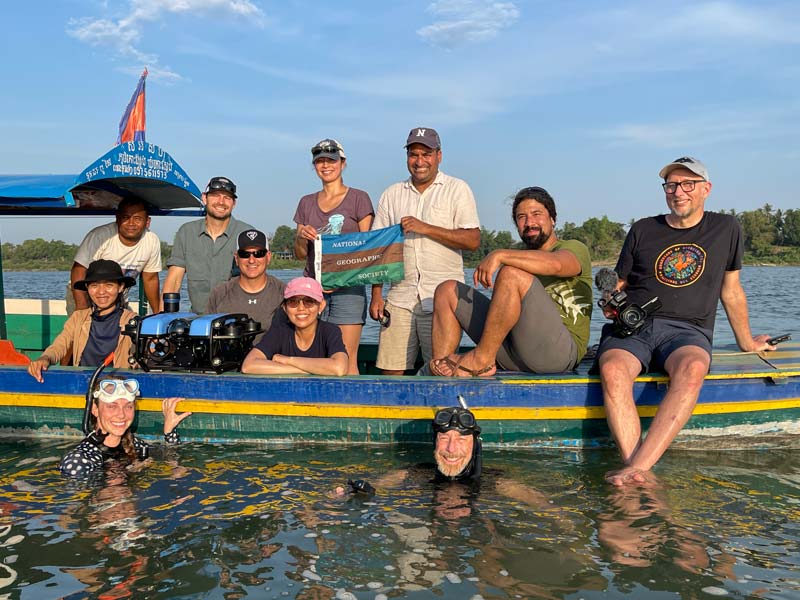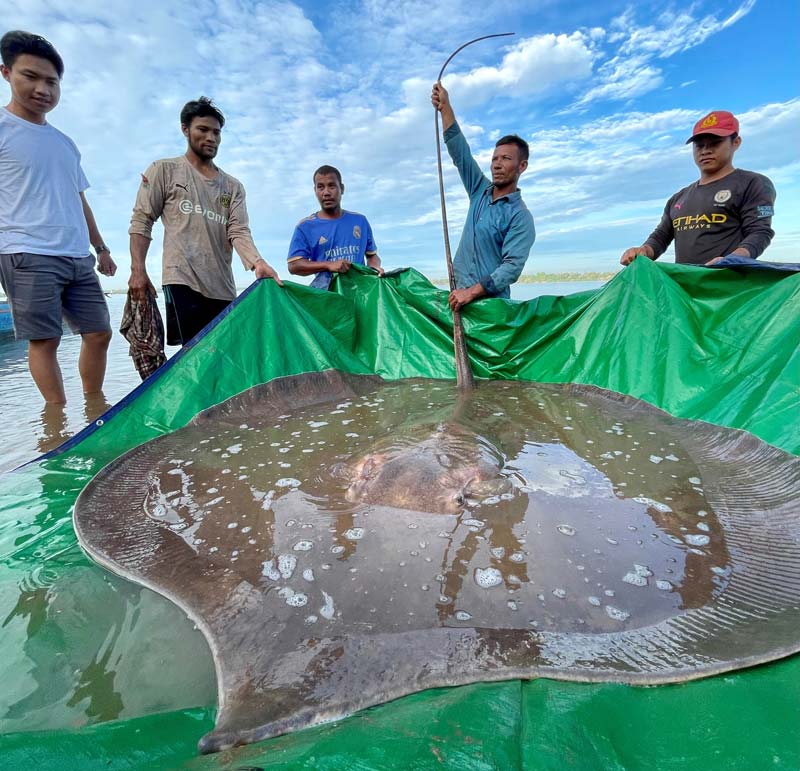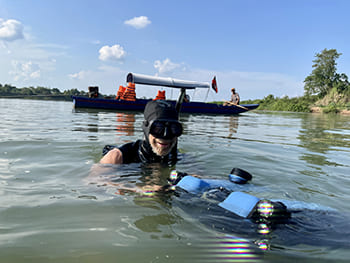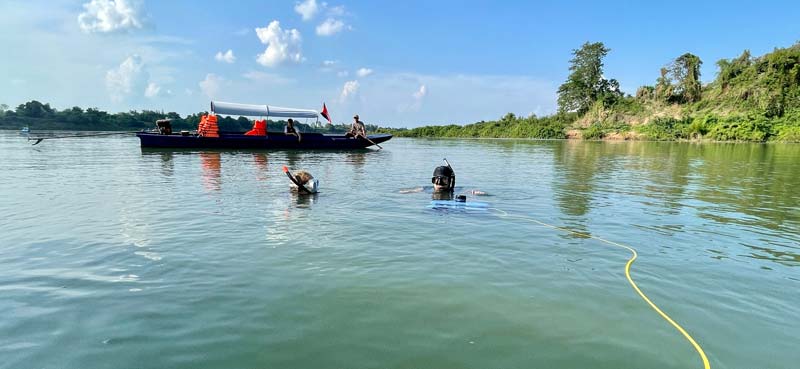An enormous and endangered fish – a 400-pound, 13-foot-long giant freshwater stingray – was hooked by fishermen from a small island community in the middle of the Mekong River on May 5, 2022.
The catch, together with other data collected by a recent scientific expedition to the area, suggests that the remote site – which is characterized by pools up to 260 feet deep and is an essential habitat for such iconic animals like Irrawaddy dolphins and giant softshell turtles – could also be home to the world's largest freshwater fish.
Interviews with fishers working in the region suggest that the 400-pound ray caught last week is dwarfed by other catches of perhaps twice the size in the same remote area over the past 20 years.
“The fishers here tell stories of catching record-breaking stingrays and other giant fish,” Zeb Hogan, College of Science fish biologist and project lead of the USAID-funded Wonders of the Mekong project, said. “It's a true wonder that a place like this still exists.”
The stingray was caught in the middle of the Mekong River near Koh Preah village, Koh Preah Commune, Siem Bouk District, Stung Treng Province. Koh Preah is an island in the Mekong with 90-foot- deep pools nearby in the river.

Members of the Wonders of the Mekong team worked with local fishermen to rescue the massive ray, which was captured incidentally after it swallowed a smaller fish that had eaten a baited hook. The rescue team was able to unhook the ray, weigh and measure it, and release it back to the river unharmed. The successful release highlighted the utility of the project's fisher network to study and conserve the rare and unusual biodiversity of the Mekong River.
"Through our project conservation activities, the villagers, including old and young people, can see with their own eyes the stingray swam back into the river," Chhut Chheana, communications coordinator at the Wonders of the Mekong project, said. "To me, this is the beginning of conservation activities and knowledge that comes to villagers' minds as they have never gotten it before. And this scene of conservation activities will stick in their mind forever, and the younger generation will join the conservation activities as volunteers, I hope."

The giant freshwater stingray, one of Southeast Asia’s largest and rarest fish, was the focus of a recent USAID-funded Wonders of Mekong project expedition to Stung Treng Province, Cambodia. The expedition's basecamp was adjacent to one of the Mekong's deepest pools and a fish reserve designed to protect spawning fish. The area itself is dotted with islands covered in seasonally flooded forests and occupied by small fishing camps.
The stingray catch was preceded by the week-long expedition led by Hogan and an international team of explorers and scientists that including Kenny Broad, an environmental anthropologist and cave diver from the University of Miami; Kakani Katija, a deep-sea explorer, and her team from Monterey Bay Aquarium Research Institute; Sudeep Chandra, a College of Science limnologist who has studied the world's largest and deepest lakes; Ngor Pengbun, Cambodia's preeminent fish biologist with 25 years of experience studying fish and fisheries throughout Cambodia; and Chea Seila, a long-time community expert with deep knowledge of the Stung Treng area.
The study area is located just downstream of a Ramsar wetland of international importance. It is home to many of the Mekong's almost 1,000 fish species, including most of the Mekong's imperiled giants – like the giant stingray, Mekong giant catfish and giant barb – all of which may grow to 600 pounds and 10 feet in length. Researchers believe the area is critically important as a dry season fish refuge and spawning site and as a last habitat of many endangered giant fish. It is a region that is recognized as special and protected by local communities.
Hogan said the rescued stingray and its habitat highlight characteristics of the Mekong's aquatic ecosystems generally: diverse, globally significant, poorly understood and under threat.
"They are unseen worlds, underappreciated and out of sight,” he said.
Leading up to the field expedition, the Wonders of the Mekong scientists conducted community and market surveys to gather information about aquatic biodiversity. In collaboration with the Cambodian Fisheries Administration, the Wonders of the Mekong project also established a network of fishers who agreed to report catches of giant and endangered fish.
During the expedition – the first of its kind – the team used unmanned submersibles equipped with lights and cameras, drop cameras suspended on long cables, and baited video cameras as their eyes and ears. The team also sampled for environmental DNA to look for rare or undetected species and will set up a telemetry array next month to monitor fish migrations through the deepest areas.
Despite its size and threatened status, the giant freshwater stingray is an understudied species. A major reason why scientists know so little about it is because the fish inhabit remote, murky waters. They’re not considered a good food fish in Southeast Asia, so they’re rarely targeted by fishers. However, they occasionally get caught accidentally, as in the case of this ray.
While it packs a poisonous, serrated stinger up to 15 inches long, it’s typically a non-aggressive, inquisitive creature, Hogan, a research professor in the Department of Biology said. He first saw a giant freshwater stingray in the Mekong River in Cambodia more than 20 years ago.
In the deep pool expedition, the team was able to capture on video schools of migratory catfish 250 feet below the surface. One species, known as "trey chhwiet" in Cambodia, once migrated over the nearby Khone Falls in April and May and formed the basis of a communal fishery on Don Sadam island before the construction of the Don Sahong Dam near the Lao-Cambodia border in 2020.

Submersible with cameras ready to dive into deep pools
Another species, Helicophagus waandersii, is known as the "mouse-faced fish" because of its long whiskered snout. This species uses its long snout to feed on mollusks, shrimp and other invertebrates on the river bottom.
“The deep pool inventory is one of many Wonders of the Mekong activities that highlights the importance of a healthy, connected river, and the people, fisheries, wildlife and water quality that aquatic ecosystems support,” Seila, program manager for Wonders of the Mekong, said. "The cooperative project with USAID and local organizations are working with communities who want to protect the river and build more resilient communities threatened by upstream dams and proposed new dams in the area."
Much of the underwater videos also recorded plastic waste, which, unfortunately, appears common even in the deepest stretches of the Mekong River, along with “ghost nets,” fishing nets that have been abandoned by fishers but can continue to snare fish.

There are now plans to build several dams in Cambodia’s portion of the river, which conservationists say will have devastating ecological effects and could seriously threaten local food security in an area of the world already impacts by changing climate. Mekong fish provide 76% of protein consumed in Cambodia. The Mekong countries have long been tapping their natural resources for economic growth and have installed numerous dams for hydropower and other purposes.
“The accelerating pace of development and dam-building, coupled with cumulative impacts of transboundary stressors and the impending impacts of climate change, point to a common concern among those who work and live in the lower Mekong River Basin: a fear that the river, which is the lifeblood of most of Southeast Asia, will gradually become so fragmented it will lose function and thus no longer support the huge diversity of wildlife and millions of people that depend on it,” Chandra, director of the University's Global Water Center, said.
"The existence of these places – like the unseen world of the Mekong's deep pools and the animals that live there – are a true underwater wonder that warrants our attention, care and protection,” Hogan said. “We must act now before species like the giant freshwater stingray are gone forever.”
The Wonders of the Mekong research is in partnership with the Cambodian Fisheries Administration, the Royal University of Agriculture and local communities and rangers of the Stung Treng Ramsar site.















